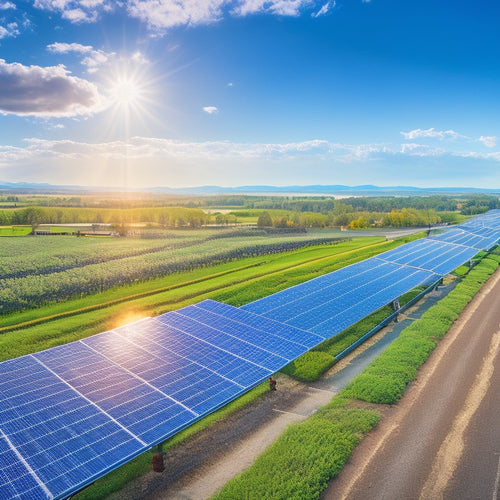
Home Electric Battery Storage
Share
You're considering home electric battery storage to change your energy environment, and for good reason. By integrating a battery storage system, you'll reduce your carbon footprint, minimizing reliance on fossil fuels and lowering your energy bills by up to 50%. You'll optimize energy usage, reduce waste, and make the most of renewable energy sources like solar and wind power. With advanced battery technology, you'll enjoy a longer lifespan, higher energy density, and improved performance. By understanding your daily energy usage patterns, you'll be able to determine the right battery size and management strategy for your needs. Now, explore how to maximize your energy independence and savings.
The Essentials
- Integrating home electric battery storage lowers emission rates, reduces reliance on fossil fuels, and minimizes carbon footprint.
- Home electric battery storage optimizes energy usage, reduces waste, and can save homeowners up to 50% on energy bills.
- Lithium-ion batteries offer high energy density and long lifespan, making them a popular choice for home electric battery storage systems.
- Understanding daily energy usage is crucial for determining battery size and maximizing savings and efficiency.
- Regular maintenance practices, such as avoiding deep discharges, can enhance battery lifespan and performance, ensuring a longer return on investment.
Reduce Carbon Footprint Now
By integrating home electric battery storage into your clean energy system, you can notably lower emission rates now, reducing your reliance on fossil fuels and minimizing your carbon footprint.
This means you'll produce fewer greenhouse gases, contributing less to climate change.
With the ability to store excess energy generated by your solar panels Home Solar Battery, you can enjoy a reliable backup power source during periods of low production or grid outages, and reduce your reliance on non-renewable energy.
With clean energy for homes, you'll be generating power from renewable sources like solar or wind, decreasing your impact on the environment.
Lower Emission Rates Now
Your carbon footprint is directly tied to your energy consumption, and the good news is that you can reduce it considerably by adopting home electric battery storage.
By integrating renewable energy sources like solar and wind power into your energy mix, you can considerably lower your reliance on fossil fuels and decrease your carbon emissions.
With home electric battery storage, you can store excess energy generated by these sources during the day for use during the night or on cloudy days, reducing your need for grid power.
| Renewable Energy Source | Emission Reduction |
| Solar Power | 75% reduction in CO2 emissions |
| Wind Power | 80% reduction in CO2 emissions |
| Hybrid (Solar + Wind) | 90% reduction in CO2 emissions |
| Grid Power (baseline) | 0% reduction in CO2 emissions |
Clean Energy For Homes
With a growing emphasis on environmental sustainability, homeowners are increasingly seeking ways to reduce their carbon footprint, and clean energy for homes is rapidly becoming a viable solution.
You're likely considering various options to minimize your reliance on fossil fuels and lower your energy bills. Clean energy for homes offers a promising way to achieve this goal.
By switching to a home solar power battery, you'll enjoy reduced energy expenses and the freedom to be less reliant on the grid, providing a cleaner, more sustainable, and self-sufficient lifestyle for you and your family.
One effective approach is solar panel integration, which involves utilizing sunlight to generate electricity. By installing solar panels on your rooftop, you can greatly reduce your energy consumption from the grid.
Additionally, with a home electric battery storage system, you can store excess energy generated during the day for use during the night or on cloudy days. This setup enables you to achieve energy independence, reducing your reliance on the grid and minimizing your carbon footprint.
Lower Your Energy Bills
By installing a home electric battery storage system, you'll reduce energy waste by optimizing your energy usage and storing excess energy generated by your solar panels or grid during off-peak hours.
According to various studies, home battery storage systems like Tesla Powerwall can save homeowners up to 50% on their energy bills.
This means you'll cut energy waste today and reduce your reliance on the grid during peak hours when rates are highest.
As a result, you'll see a direct impact on your monthly energy bills, with significant cost savings over time.
Cut Energy Waste Today
As energy consumption continues to rise, so do the costs, and it's becoming increasingly important to address the issue of energy waste in our homes. You're likely aware that a significant portion of your energy bill is attributed to standby power consumption, inefficient appliances, and poor insulation. By cutting energy waste, you'll not only reduce your carbon footprint but also lower your energy bills.
To achieve energy efficiency, you'll need to identify areas of waste in your home. Here's a breakdown of common energy-wasting culprits:
| Area of Waste | Description | Solution |
|---|---|---|
| Standby Power | appliances continue to draw power when turned off | smart plugs or power strips |
| Inefficient Lighting | traditional incandescent bulbs waste energy | LED or CFL bulbs |
| Poor Insulation | heat escapes through walls and windows | insulation upgrades or energy-efficient windows |
| Old Appliances | outdated appliances consume more energy | energy-efficient replacements |
| Phantom Loads | devices continue to draw power when not in use | smart technology or manual shut-off |
Reduce Monthly Costs Now
You've identified areas of energy waste in your home and are taking steps to address them. Now, it's time to reduce your monthly energy bills.
By integrating solar power into your home electric battery storage system, you can greatly lower your energy costs. With solar integration, you can utilize the free energy from the sun to power your home, reducing your reliance on the grid. This means you'll be paying less to your utility company each month.
Smart management of your energy storage system is also vital in reducing your energy bills. With advanced smart management software, you can monitor your energy usage in real-time, identifying areas where you can optimize your energy consumption.
This software can also automatically switch to battery power during peak energy usage hours, reducing your energy costs even further. By combining solar integration with smart management, you can maximize your energy savings and enjoy greater freedom from the grid.
With a home electric battery storage system, you're in control of your energy costs, and you can start saving money now.
Deep Cycle Battery Design
When selecting a deep cycle battery for your home electric battery storage system, you'll want to evaluate the battery cell chemistry, as it directly impacts the overall performance and lifespan of the battery.
It's important to choose a battery that's compatible with your solar panel system, ensuring a seamless integration for ideal energy harvesting grid tie system.
You'll need to decide between flooded lead-acid, sealed lead-acid, or lithium-ion batteries, each with their own strengths and weaknesses.
The cycle life expectancy of the battery is also significant, as it determines how many charge and discharge cycles the battery can handle before its capacity starts to degrade.
Battery Cell Chemistry
The heart of any deep cycle battery lies in its cell chemistry, which greatly impacts performance, lifespan, and overall efficiency. You'll want to understand the pros and cons of each chemistry type to choose the best fit for your home electric battery storage needs.
Lithium-ion batteries are a popular choice due to their high energy density, long lifespan, and low self-discharge rate. They also offer several advantages, including high battery efficiency, making them a great option for those seeking to maximize their energy storage.
Here's a comparison of common deep cycle battery cell chemistries:
| Chemistry Type | Cycle Life | Depth of Discharge | Self-Discharge Rate |
|---|---|---|---|
| Lead-Acid | 200-500 | 50% | 3-5% per month |
| Nickel-Cadmium | 1000-1500 | 80% | 1-2% per month |
| Lithium-Ion | 2000-3000 | 80% | 1-2% per month |
| Nickel-Metal Hydride | 500-1000 | 80% | 1-2% per month |
| Sodium-Ion | 1000-2000 | 80% | 1-2% per month |
When selecting a deep cycle battery, consider your specific needs and weigh the advantages and disadvantages of each chemistry type. By doing so, you'll be able to make an informed decision and achieve the freedom and independence you desire from your home electric battery storage system.
Cycle Life Expectancy
As you evaluate different deep cycle battery options for your home electric battery storage system, it's vital to contemplate the cycle life expectancy of each design.
The cycle life expectancy of a deep cycle battery refers to the number of charge and discharge cycles it can perform before its capacity degrades to a certain level. A higher cycle life expectancy indicates a longer-lasting battery, which can greatly reduce your overall costs.
When reviewing cycle life expectancy, consider the battery's design and construction. Look for batteries with a sturdy design, high-quality materials, and a proven track record of performance.
It's also important to follow proper battery maintenance tips, such as avoiding deep discharges, keeping the battery at room temperature, and ensuring proper ventilation.
Additionally, adopt ideal charging practices, like avoiding overcharging and using a high-quality charger. By doing so, you can maximize your battery's cycle life expectancy and enjoy a reliable and efficient home electric battery storage system.
Consider Your Daily Kwh
You need to understand your daily energy usage to determine the right battery size for your home electric battery storage system.
To do this, you'll want to calculate your daily kilowatt-hours (kWh) and break it down into an hourly usage pattern.
Considering your energy usage patterns is essential in maximizing energy savings with renewable energy solutions and reducing electricity bills.
Daily Energy Usage
Daily energy usage is an essential factor to take into account when evaluating home electric battery storage solutions. You need to understand your energy consumption patterns to determine the right size and type of battery storage system for your home.
Your daily habits play a considerable role in shaping your energy consumption. For instance, do you have a large family that uses multiple appliances simultaneously, or do you live alone with minimal energy requirements?
Do you work from home, which means you're using energy-intensive devices like computers and printers throughout the day? Or are you away from home for most of the day, resulting in lower energy usage?
You should also consider your energy-intensive appliances, such as refrigerators, air conditioners, and electric water heaters. These appliances can considerably impact your overall energy consumption.
Kwh Hourly Breakdown
Understanding your daily energy usage patterns is essential, and a key aspect of this is analyzing your kWh hourly breakdown. This breakdown shows you how much energy you're using during each hour of the day, helping you identify peak usage periods and optimize your energy efficiency.
By examining your kWh hourly breakdown, you can determine when you need the most power and adjust your energy storage strategy accordingly.
To get the most out of your home electric battery storage, you'll want to evaluate your daily kWh usage and how it aligns with your battery capacity. If you notice that you're using a lot of energy during the evening hours, for example, you may want to prioritize charging your battery during off-peak hours when energy rates are lower.
This can help you reduce your energy costs and increase your energy independence.
Longer Cycle Life Guaranteed
You'll want to prioritize battery durability when choosing a home electric battery storage system, as it directly impacts the overall performance and lifespan of your energy storage solution.
A longer cycle life guarantee guarantees your battery will retain its capacity to store and release energy over a greater number of charge and discharge cycles. This means you'll get more value from your investment, with a battery that continues to meet your energy needs over an extended period.
Battery Durability Matters
With the increasing adoption of home electric battery storage, manufacturers are under pressure to deliver high-quality products that can withstand the rigors of repeated charging and discharging.
You want a battery that can perform at its best over its lifespan, and that's where durability matters. A longer cycle life is essential, as it directly impacts your battery's overall performance and ROI.
When evaluating battery durability, you should consider factors like depth of discharge (DOD), charge cycles, and operating temperatures.
Look for batteries with a high DOD tolerance and a proven track record of withstanding extreme temperatures.
Regular maintenance practices, such as monitoring battery health and updating software, can also extend the lifespan of your battery.
Frequently Asked Questions
Can I Charge My Electric Vehicle With a Home Battery Storage System?
When considering charging your electric vehicle, you'll want to ascertain the battery storage system you choose offers charging compatibility and sufficient battery capacity to meet your needs, allowing you to recharge efficiently and freely.
Are Home Electric Batteries Prone to Overheating or Fires?
You're right to wonder about fire risks; lithium-ion batteries, in general, can overheat or ignite if not designed with proper thermal management and safety features, but reputable manufacturers prioritize battery safety to minimize these risks.
How Long Does It Take to Install a Home Battery Storage System?
When you decide to invest in a battery storage system, you'll spend around 2-5 hours on the installation process, depending on the complexity of the system components, which typically include a battery pack, inverter, and monitoring system.
Can I Use My Home Battery Storage System During a Power Outage?
Like a guiding light in the dark, you'll have backup power during outages, thanks to your system. Yes, you can use it then, and with proper maintenance, your battery lifespan will be extended, ensuring your freedom from grid dependence.
Are Home Electric Battery Storage Systems Eligible for Government Incentives?
You're likely eligible for government incentives when investing in renewable energy solutions; many incentive programs offer tax credits for homeowners, and you can claim these credits when filing your taxes, enhancing your system's overall value.
Final Thoughts
As you weigh the benefits of home electric battery storage, consider this stark contrast: on one hand, a continued reliance on fossil fuels, perpetuating climate change and draining your wallet; on the other, a cleaner, more affordable energy future, made possible by state-of-the-art deep cycle battery design. By pairing solar power with daily kWh-aware storage, you'll not only reduce your carbon footprint but also lower your energy bills. The choice is clear: invest in a sustainable tomorrow, guaranteed by a longer cycle life.
Related Posts
-

Smart Home Thermostats to Revolutionize Your Space
Smart home thermostats revolutionize your space by providing precise temperature control and optimizing energy saving...
-

Applications of Photovoltaic Systems
Photovoltaic systems are versatile, converting sunlight into electricity for various applications. You can use them i...
-

Top-Rated Home Solar Power Kits for Achieving Energy Independence
Top-rated home solar power kits enable you to achieve energy independence by greatly cutting your energy costs. You c...


